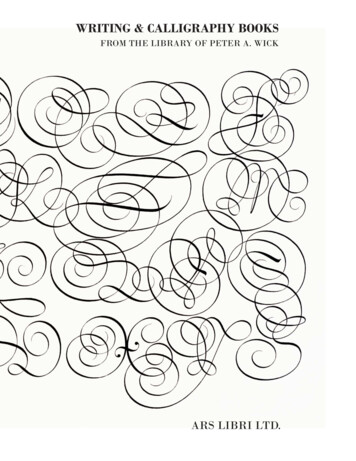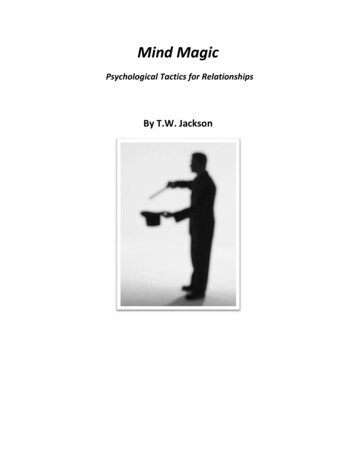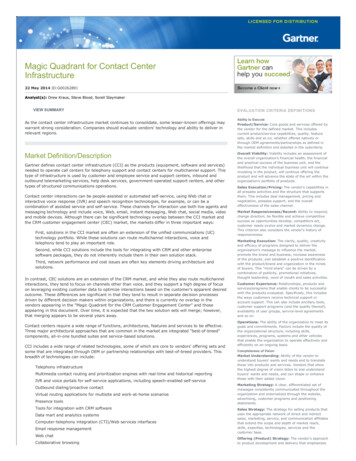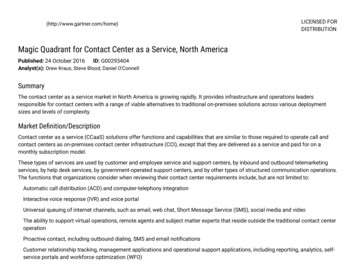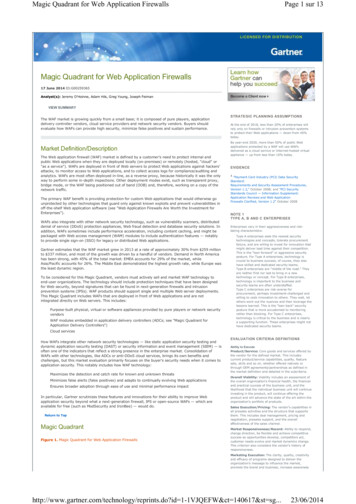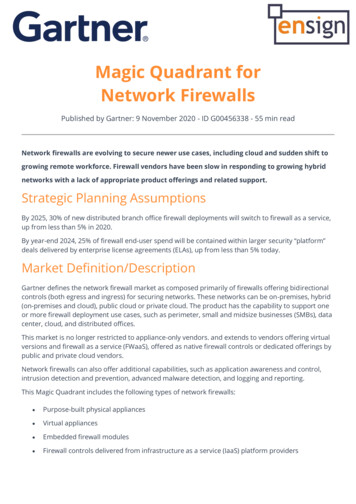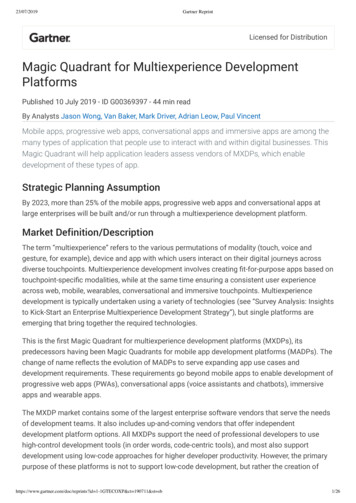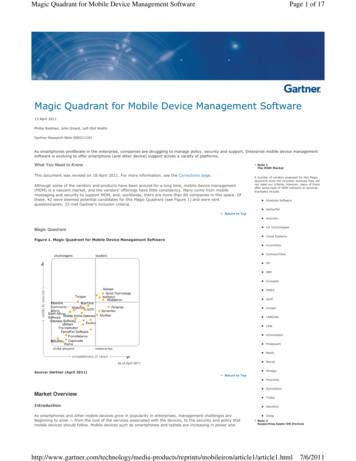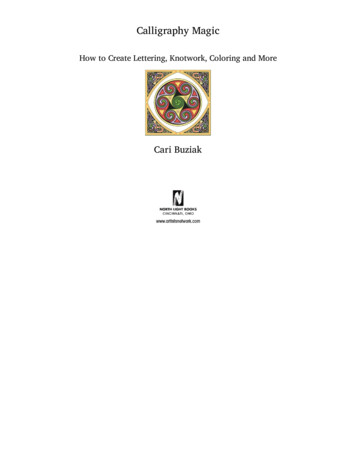
Transcription
Calligraphy MagicHow to Create Lettering, Knotwork, Coloring and MoreCari Buziak
Table of Contents
Table of ContentsIntroductionGlossary of TermsCHAPTER 1 Calligraphy Tools and SuppliesCHAPTER 2 How to Make Calligraphy StrokesCHAPTER 3 15 Alphabets From Basic to FancyCHAPTER 4 Ornamentation, Gilding & ColoringCHAPTER 5 12 Calligraphy Projects Step by StepSTATIONERY AND EVENT ANNOUNCEMENTSBookplatesGreeting CardsBookmarksLogosBusiness Cards and LetterheadWedding AnnouncementsInvitationsPlace Cards and Thank-You’sDISPLAY PIECESMonogramsQuotationsCertifi catesLettering with Celtic DecorationIllustrated PoemsLettering with Dragon ArtworkCHAPTER 6 Creating Your Own Computer FontsPre-printed Celtic Knotwork Grid PaperPre-ruled Calligraphy Practice PagesIndexAbout the AuthorDedicationAcknowledgments
Introduction
IntroductionCalligraphy is a fun craft to learn, as well as a useful one. Far from being an obsolete skill, more and more people today are picking upthe pen and creating their own greeting cards, wedding invitations, fine art projects, and even creating their own computer fonts!In the old days, calligraphy tools were unique and speci cally crafted to their task. Today, a calligrapher has a wide variety of toolsfrom which to choose, from traditional to completely modern, even digital! Calligraphers can now experiment with their artisticexpression, freely mixing creative ideas and elements together to explore new artforms with their projects. In this book we’ll examinethe basic techniques of calligraphy, covering calligraphy hands suitable for a wide variety of projects and easy for a beginner orintermediate calligrapher to practice and learn. We’ll also cover easy decorative techniques such as watercolor painting, Celtic knotwork,gold lea ng and illustration ideas to create a “toolkit” of creative techniques. You’ll learn how to make your own wedding stationery,create a painted greeting card or a birth announcement, design a logo for your own business, and so much more! We’ll cover all thesteps from basic layout to design choices to the final completed piece in easy step-by-step examples.Calligraphy is a way of expressing yourself and learning something new in an art eld that has lots of potential for new discoveries—nding new ways to embellish your lettering, learning a new alphabet, or creating memorable keepsakes with a handmade touch foryourself, family and friends.
Glossary of Terms
Glossary of TermsAscenders & DescendersA letter has three main parts: the x-height, the ascender, and the descender. The main body of the letter lls the x-height (for example,the lowercase “o”); the ascender rises up above the x-height (the stem of the “d”); and the descender falls below the x-height (the stemon the lowercase “p”).FontA typeface (alphabet) used on a computer (as opposed to letters used on a printing press, or hand written).Font FamilyA font family includes a number of related font faces, such as a bold version, condensed, italic, light, etc.CursiveA more uid or script style of writing, developed as a faster way to write by monks. Cursive usually has a looser and less formal look.It’s useful for projects that need letters that flow and move in the design without looking too formal or stiff.MajusculeCapital or uppercase letters in an alphabet. Also great for creating a splash at the beginning of a text with a larger or more detailedletter. Often used for monograms, or a detailed piece in stand-alone uses where there may not be any other text or designs in a project.A highly decorated Majuscule used at the beginning of a word or sentence is called a “Display Capital.”MinusculeLowercase letters in an alphabet. Some minuscule letters lend an informal look to a piece of text, and can be used in projects where alighter or more inviting feel is desired.UncialA style of writing characterized by full, rounded letters. Capitals from our modern Latin alphabet are derived from Uncial styleletterforms.SerifA small stroke at the beginning or end of a main stroke. A serif can be made in many ways and often gives a particular alphabet itscharacteristic look.GlyphAny graphic within a font. This can be a letter, number, or a symbol such as a dollar sign or punctuation.EncodingEach glyph is encoded with instructions so that the computer knows to type an “A” when you press the “A” key on your keyboard. Atone time Macs and PCs used di erent encoding instructions or standards; however the new Unicode Standard is a universal standard thatboth Macs and PCs will recognize and understand and what we’ll be using in our discussions here.MetricsSpacing rules that you want your font letters to follow so that they’re spaced correctly when you type words and paragraphs.Color Hue/Tint/ShadeHue is pure color. Tint is color plus white. Shade is color plus black.Complementary ColorsColors opposite each other on the color wheel. Complementaries can create strong and bold color pairings.Triad ColorsThree colors, each one-third away from each other on the color wheel. Triads can also create a very bold color combination.Split Complementary ColorsInstead of using the direct complementary color, you use the two colors to either side of the complementary. This combination is moresubtle, and good for more reserved pieces.GildingThe application of tissue-thin sheets of metal (gold, silver, copper) to a sticky surface.
CHAPTER 1Calligraphy Tools and SuppliesCalligraphy is not an expensive craft to learn. With some basic pen supplies and papers you can immediately begin learninghow to create beautiful letters.Sketching ToolsTo sketch your designs and plan your layout you’ll need a pencil or two and a good eraser. These actually come in a much wider varietythan what we’ve all used in grade school! Having a few choices in pencil leads and a good eraser to use can mean the di erencebetween ghting your materials while you work, and getting into the groove of your project, so it’s more than worth the small cost topurchase these.PENCIL HARDNESSPencils come in di erent hardnesses of lead, from 6B (which draws very soft, smudgy black lines) to 6H (which draws hard, thin, silverylines). For calligraphy or for sketches that will be colored over, buying a normal HB pencil and a 2B or 2H will suffice.TYPES OF PENCILSYou can buy your pencils as normal pencils that are sharpened with a pencil sharpener, a holder that can accept leads of any hardness,or a mechanical pencil. I prefer to work with mechanical pencils because they don’t have to be sharpened. I buy a few of those brightlycolored plastic mechanical pencils in different colors and color-code what pencil holds which hardness of lead.VINYL ERASERSVinyl erasers are a standard for sketching. They come in a variety of sizes, however I nd the easiest thing to do is buy a big block andthen use a utility knife to cut it down to whatever size I need. I also trim o the corners of the rectangular eraser into small wedges that Iuse to erase in tiny places—very handy for detail work when drawing embellishments and designs!KNEADABLE ERASERS
Although a kneadable eraser is sold in a rectangular form, you can knead it into any shape you want! Rather than rubbing it across yourwork like a normal eraser, press it against your pencil lines, then lift it o . Since it only removes a bit of the drawn lines at a time youhave a lot of control with how much you lighten or remove. It’s also great for sensitive papers because it gently removes the pencil lineson delicate papers that could be abraded or ruined by rubbing.Calligraphy PensCalligraphy can be written with any wide chisel-shaped tool, whether it’s a pen, a felt, or the reed from a musical instrument! The key isthe chisel-shaped edge used to make the letters. By holding the chisel edge at a consistent angle and moving it around your paper, it willcreate thin and thick lines automatically for you.The three main types of pens used in calligraphy are the traditional dip pen, a cartridge style pen, and a felt tip pen. Try each to seewhat you’re most comfortable with across a variety of uses. For practicing and planning pieces it’s handy to whip out some text with afelt pen, while expressive works and works needing a wide range of nib widths would work better with a dip style pen. A cartridge stylepen is handy for long pieces of text that need consistent letters because you just load it up and start writing!Each is useful in its own way, but if you can only buy one style, I would recommend buying the dip pen holder and some nibs and inkbecause it’s the most exible to work with overall. Once you become more familiar with calligraphy, experiment with any chisel shapedobjects you can find!FELT TIP PENSThe felt tip pen is like an ordinary felt pen, except that the tip has a wide chisel edge, not a point. A great tool for beginners, these pensare inexpensive, do not require reloading or lling with ink, and come in a variety of colors and widths. However, because the tip ismade from felt, it can wear down and soften over time and you’ll lose your nice crisp edge for lettering. Also, the ink isn’t archival so it’snot suitable for important projectsCARTRIDGE STYLE PENSThe cartridge style pen works like a fountain pen, except that it has a chisel nib for making calligraphic letters. To use these, you insertink cartridges into the pen and add your preferred nib. Inks come in a variety of colors, and nibs in a variety of widths.These pens are nice for students because you get an automatic flow of ink as you write, and you can write for a very long time withouthaving to change ink cartridges. However, it can be tedious to change colors or nib widths because the ink chamber and nib must bethoroughly cleaned and flushed free of any ink that could dry inside.Calligraphy Pens
DIP STYLE PENSA dip style pen, the kind you see in old movies that is usually associated with calligraphy, has a handle with a small opening atone endwhere the calligraphy pen nib is inserted. It’s very simple to change nib widths and colors because the nib is accessible and easy to clean.However it does take a bit of practice to gure out how much ink to load into the nib, and to gauge when you’re going to run out andneed to redip.DIP STYLE NIBSDip style nibs of any brand have common features. They each have a shaft that ts into the pen holder, the main part of the nib headthat has the ink reservoir, and the chisel tip. The chisel tip can be purchased in a wide variety of widths, depending on the kind ofletters you’ll be making and how big they’ll be. Most nibs have the ink reservoir already attached, however some brands, such as theMitchell nibs, have a small separate piece that slides on to the nib to create the reservoir.Nib CareBefore using your nibs for the rst time, you’ll need to clean the manufacturer’s grease and varnish from them for the ink to owproperly. You can do this by holding the nib tip in a cup of boiling water for a short time and then wiping it dry, or you can add a fewdrops of gum arabic to the nib and then wipe it off; no need to rinse.In between colors or after use, your nib should be thoroughly cleaned with an old toothbrush and soapy water, and patted dry. It’sespecially important not to let waterproof ink dry on your nibs or they’ll be very diffi cult to clean or use.InksA dip style calligraphy pen can be used with a number of liquid mediums, however most commonly you’ll be looking for ink. Ink canbe sold by the stick or bottle, and in any color of the rainbow! What ink you choose depends on your project and on what you ndworks best for how you like to work.
PIGMENTED INKS VS. DYESInks can be made from pigments, or dyes. Pigments can make the ink feel a little grainy when you write with it because it’s an ink madeup of tiny particles that give the ink its color. It can also settle out both in the jar (always make sure you shake well!) and on the page,which can give interesting effects if you use a textured paper. Dye-based inks are not lightfast, so will fade over time.PAINTS AS INKSYou can also use watercolor, gouache or liquid acrylic with your dip pens (use artist-quality or student-grade to ensure strong colors andease of workability). Each comes in a wide array of colors and opacities, and needs to be thinned before use with your pen. Use apaintbrush to fill the reservoir of your dip pen nib with paint. When using acrylic, always wash your dip pen nib thoroughly after use, oreven during use, as the paint dries quickly and can clog your pen.WATERPROOF OR WATER SOLUBLE?Whether you choose to work in waterproof or water-soluble ink depends on your project.Water-soluble inks can be good for practice work because you don’t have to be as careful about the ink drying on the pen nib, and it’seasier to clean up and change colors. Waterproof inks are hard to clean o your nib if left to dry, so are best used for nished workwhere you need the ink to stay in place no matter what.INK STICKS
Ink sold in stick form must be liqui ed before use. This is done against a special stone that has a well in the center. The well is lledpartway with water, and the ink stick is lightly rubbed against the stone into the water until the fresh ink has the consistency desired.Cartridge Pen InksThe ink sold for cartridge style pens is water soluble so it doesn’t dry up in the pen and ruin it. Also, because of the ne mechanismwithin a cartridge style pen that allows the ink to ow, the cartridges contain a dye based ink which can fade. Choose black if you needthe letters to last for a long time as the bright colors are the worst offenders for fading!PapersThere are numerous options of suitable papers to use for calligraphy, depending on your project, personal preference, and budget. Thepaper you choose can add character or even color to your piece, and can be a source of inspiration for future projects.WATERCOLOR PAPERWatercolor paper comes in di erent nishes: very smooth (called smooth, or hot pre
Lettering with Dragon Artwork CHAPTER 6 Creating Your Own Computer Fonts Pre-printed Celtic Knotwork Grid Paper Pre-ruled Calligraphy Practice Pages Index About the Author Dedication Acknowledgments. Introduction. Introduction Calligraphy is a fun craft to learn, as well as a useful one. Far from being an obsolete skill, more and more people today are picking up the pen and creating
